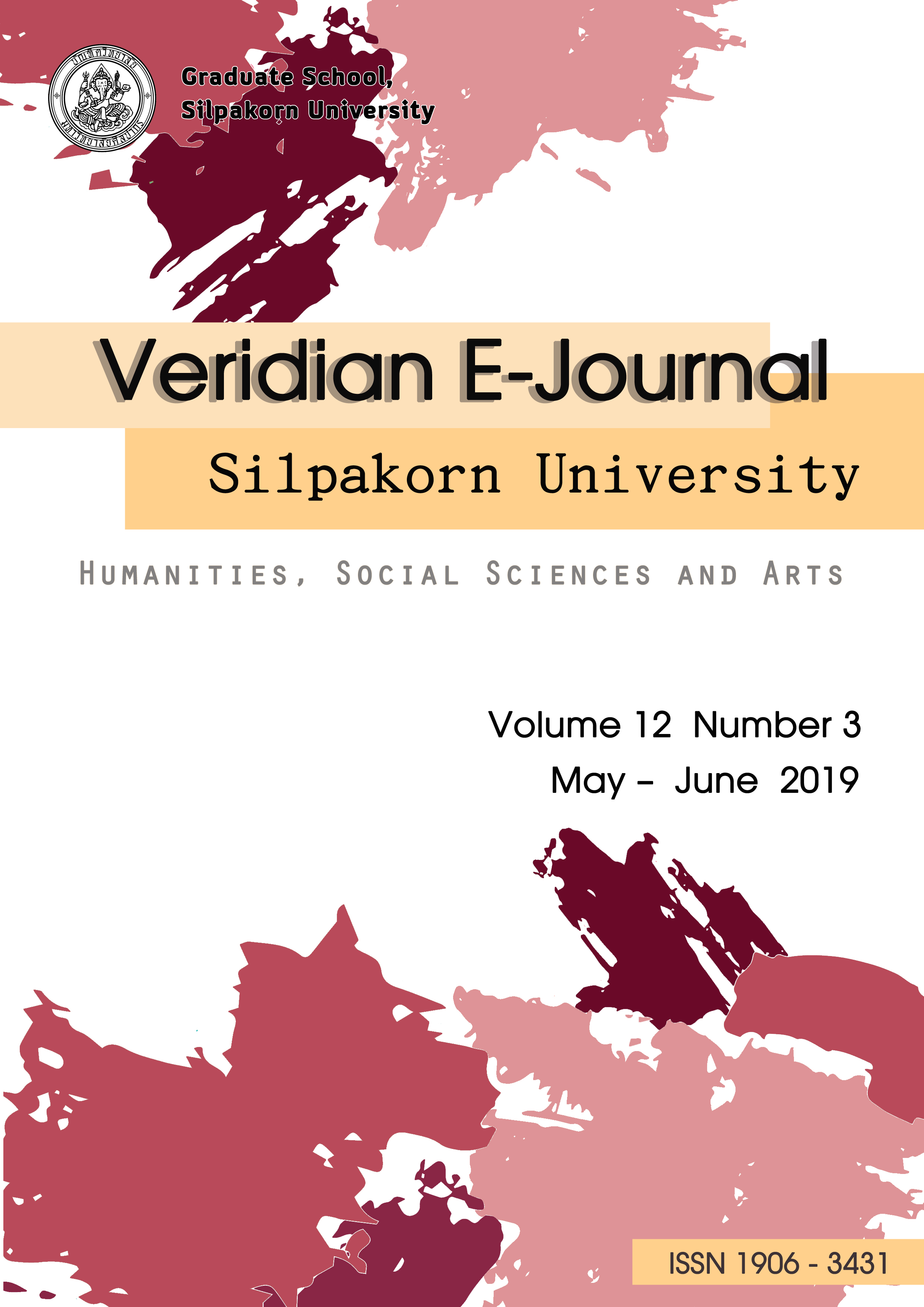การพัฒนารูปแบบการจัดการเรียนรู้ตามแนวคิดการจัดการความรู้เพื่อส่งเสริมจิตสำนึกอนุรักษ์มรดกศิลปวัฒนธรรมไทย สำหรับนักศึกษาระดับปริญญาตรี (The Development of Learning Provision Model Using Knowledge Management to Enhance Thai Art And Cultural Heritage Conservative Consciousnessfor Undergraduate Students)
Main Article Content
บทคัดย่อ
การวิจัยครั้งนี้มีวัตถุประสงค์เพื่อ 1) พัฒนารูปแบบการจัดการเรียนรู้ตามแนวคิดการจัดการความรู้เพื่อส่งเสริมจิตสำนึกอนุรักษ์มรดกศิลปวัฒนธรรมไทย สำหรับนักศึกษาระดับปริญญาตรี2) ประเมินประสิทธิผลการใช้รูปแบบการจัดการเรียนรู้ตามแนวคิดการจัดการความรู้เพื่อส่งเสริมจิตสำนึกอนุรักษ์มรดกศิลปวัฒนธรรมไทย สำหรับนักศึกษาระดับปริญญาตรี กลุ่มตัวอย่างที่ใช้ในการวิจัย คือ นักศึกษาชั้นปีที่ 3 หลักสูตรครุศาสตรบัณฑิต สาขาวิชาสังคมศึกษา คณะครุศาสตร์ มหาวิทยาลัยราชภัฏกาญจนบุรี ภาคเรียนที่ 1 ปีการศึกษา 2561 ที่ลงทะเบียนเรียนรายวิชา ความรู้เกี่ยวกับโบราณวัตถุสถาน แหล่งประวัติศาสตร์และวัฒนธรรมในท้องถิ่น จำนวน 28 คน ได้มาด้วยการสุ่มอย่างง่าย โดยใช้หมู่เรียนวิชาเอกเป็นหน่วยสุ่มใช้กระบวนการวิจัยและพัฒนา (Research and Development) (องอาจ นัยพัฒน์, 2554) ร่วมกับแนวคิดการออกแบบการสอนเชิงระบบ (ADDIE Model) (Kruse, 2012) เครื่องมือที่ใช้ในการวิจัยประกอบด้วย แผนการจัดการเรียนรู้ แบบทดสอบวัดผลการเรียนรู้ แบบวัดจิตสำนึกอนุรักษ์มรดกศิลปวัฒนธรรมไทย สำหรับนักศึกษาระดับปริญญาตรี และแบบสอบถามความพึงพอใจของนักศึกษา วิเคราะห์ข้อมูลโดยการใช้ค่าเฉลี่ย (x̄) ค่าเบี่ยงเบนมาตรฐาน (S.D.) ค่าทีแบบไม่อิสระ (t-test for dependent) และการวิเคราะห์เนื้อหา (Content analysis)
ผลการวิจัยพบว่า
1) รูปแบบการจัดการเรียนรู้ตามแนวคิดการจัดการความรู้เพื่อส่งเสริมจิตสำนึกอนุรักษ์
มรดกศิลปวัฒนธรรมไทย สำหรับนักศึกษาระดับปริญญาตรี มีค่าดัชนีความสอดคล้อง (IOC) ระหว่าง 0.75-1.00 มี 4 องค์ประกอบ คือ หลักการ วัตถุประสงค์ กระบวนการจัดการเรียนรู้ 4 ขั้นตอน หรือเรียกว่า รูปแบบ
การจัดการเรียนรู้ 4 ส คือ ขั้นที่ 1 ใส่ใจในมรดกศิลปวัฒนธรรมไทย (ส-ใส่ใจ) ขั้นที่ 2 สั่งสมองค์ความรู้มรดกศิลปวัฒนธรรมไทย (ส-สั่งสม) ขั้นที่ 3 ขั้นสร้างสรรค์แนวทางการอนุรักษ์และเผยแพร่ความรู้มรดกศิลปวัฒนธรรมไทย (ส-สร้างสรรค์) และขั้นที่ 4 สืบสานคุณค่ามรดกศิลปวัฒนธรรมไทยสู่สาธารณะ (ส-สืบสาน) และ เงื่อนไขการนำรูปแบบการจัดการเรียนรู้ไปใช้ ซึ่งประกอบด้วย ระบบสังคม ระบบสนับสนุน และหลักการตอบสนอง
2) ประสิทธิผลของรูปแบบการจัดการเรียนรู้ พบว่า 2.1) ผลการเรียนรู้รายวิชา ความรู้เกี่ยวกับโบราณวัตถุสถาน แหล่งประวัติศาสตร์และวัฒนธรรมในท้องถิ่นของนักศึกษา หลังการทดลองใช้รูปแบบการจัดการเรียนรู้สูงกว่าก่อนการทดลองใช้รูปแบบการจัดการเรียนรู้ อย่างมีนัยสำคัญทางสถิติที่ระดับ .052.2) พัฒนาการจิตสำนึกอนุรักษ์มรดกศิลปวัฒนธรรมไทยของนักศึกษาก่อนเรียน ระหว่างเรียน และหลังเรียนด้วยรูปแบบการจัดการเรียนรู้มีพัฒนาการสูงขึ้นเป็นลำดับ 2.3) ความพึงพอใจของนักศึกษาที่มีต่อรูปแบบการจัดการเรียนรู้อยู่ในระดับ มากที่สุด
This research aimed to 1) develop the learning provision model using knowledge management to enhance Thai art and cultural heritage conservative consciousness for undergraduate students 2) evaluate the effectiveness of learning provision model using knowledge management to enhance Thai art and cultural heritage conservative consciousness for undergraduate students. The sample of research corrected by simple random sampling, consisted of 28 third-year Social Studies student teachers studying in faculty of education of Kanchanaburi Rajabhat University during the first semester of 2018 academic year, who have study in the subject of Principle History Sources and Culture Source in Local Culture Area. This research applying the process of research and development (R&D) and collaboration with the instructional systems design (ADDIE model). An instruments of research included learning management plan, achievement test in the subject of Principle History Sources and Culture Source in Local Culture Area and evaluation form of Thai art and cultural heritage conservative consciousness for undergraduate student and student’s satisfaction questionnaire. The data were analyzed by mean (x̄) standard deviation (S.D.), t-test for dependent and content analysis,
The findings of the research revealed the following:
- The learning provision model using knowledge management to enhance Thai art and cultural heritage conservative consciousness for undergraduate students had index of item objective congruence (IOC) between 0.75-1.00 The learning provision model consists of four components–principles, objectives, learning process involves four steps–Concern about Thai art and cultural heritage, Collect knowledge of Thai art and cultural heritage, Create the conservation planning and disseminate Thai art and cultural heritage knowledge and Conserve the value of Thai art and cultural heritage to community, and conditions related to learning provision model implementation, which comprise a social system, a support system, and responsiveness.
- An effectiveness of learning provision were: 2.1) After learning with the learning provision model the student’s achievement test in the subject of Principle History Sources and Culture Source in Local Culture Area was significantly higher than before learning with the model at .05 level 2.2) Student’ s Thai art and cultural heritage conservative consciousness for undergraduate students were increased substantially 2.3) Student’s satisfaction toward the learning provision model was higher level most.

